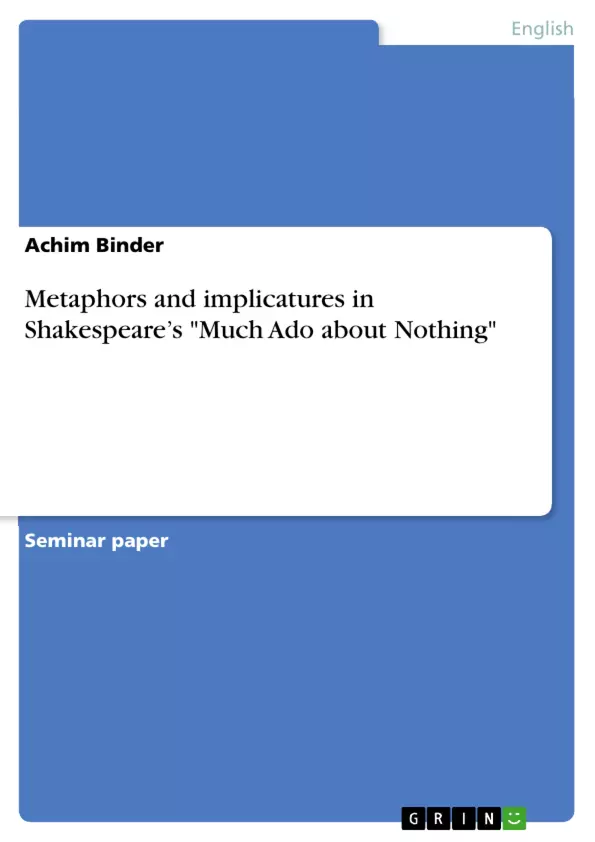For many people it seems that the application and analysis of metaphors only belongs to the field of literary studies. There are, however, such a large number of metaphorical expressions and lexicalized, so-called “frozen metaphors” in both German and English that the importance of metaphors exceeds by far their poetic usage.
For Grice, metaphors result from the flouting of the first maxim (Quality) – that of not saying what one believes to be false. Metaphorical expressions hence provoke a search for the intended speaker meaning because of the obvious discrepancy between the proposition expressed by the utterance and the “falseness” of its content. This “falseness”, however, is not always clear to see. Take, for example, the metaphor “no man is an island”. It is obviously metaphorical in both content and meaning and one could deduce a whole range of weak implicatures from it but it is in no way “literally false”.
Considering that Grice labelled tropes and figures of speech (such as tautology, irony and metaphor) as cases of “maxim exploitation” , it seems reasonable to analyse a text which allows for a maximum of maxim exploitation and whose author is responsible for a large number of frozen metaphors in English:
What makes Shakespeare (to name just one example) extraordinary is the way he exploited this ordinary aspect of communication so that a single line or phrase triggers the discovery of a whole array of implicatures.
The centre of this paper will thus be a linguistic analysis of metaphors and implicatures in Shakespeare’s play Much Ado about Nothing.
Inhaltsverzeichnis (Table of Contents)
- Introduction
- I Metaphors
- 1.1 Structural Metaphors
- 1.2 Orientational Metaphors
- 1.3 New Metaphors
- 1.4 Ontological Metaphors
- 2. Processing Effort and Contextual Effects
- 2.1 Strong and Weak Implicatures
- 2.2 Poetic Effects
- 2.3 Irony
- 3. Implicatures
- 3.1 Reference Assignment
- 3.2 Disambiguation
- 3.3 Enrichment
- 3.4 Implicating
- 3.5 Implicatures in Proverbs
- 4. Metaphorical Extension
- 4.1 Small Extensions
- 4.2 Medium Extensions
- 4.3 Large Extensions
- 5. "Double Meaning" through Weak Implicatures
- 7. Bibliography
Zielsetzung und Themenschwerpunkte (Objectives and Key Themes)
This paper explores the use of metaphors and implicatures in Shakespeare's play *Much Ado about Nothing*, analyzing their linguistic function and impact on the reader's understanding. The primary objective is to examine how Shakespeare's strategic use of these literary devices creates a rich tapestry of meaning, generating a wide range of implicatures and enhancing the overall impact of the play. Key themes explored in the paper include: * **The nature of metaphor**: Investigating how metaphors transcend their poetic function and permeate everyday language, influencing our understanding of abstract concepts. * **The role of implicatures**: Examining how implicatures, especially weak implicatures, contribute to the "double meaning" of Shakespeare's language, adding layers of interpretation and enriching the reader's experience. * **The contextuality of meaning**: Emphasizing the significance of context in interpreting metaphors and implicatures, revealing how the meaning of a metaphorical expression can change depending on the surrounding text and the historical and cultural background. * **The concept of maxim exploitation**: Exploring how Shakespeare, as a master of language, skillfully manipulates the conversational maxims, particularly the maxim of truthfulness, to generate intended meanings beyond the literal surface level. * **The interplay between metaphor and irony**: Examining the intricate connection between metaphor and irony, where both contribute to the ambiguity and multi-layered interpretations of Shakespeare's work.Zusammenfassung der Kapitel (Chapter Summaries)
The introduction provides a broad overview of the significance of metaphors and their role in shaping human thought and communication. It discusses the work of Lakoff and Johnson, who argue that metaphors are fundamental to our conceptual system, and highlights Grice's theory of implicatures, which classifies metaphors as a type of conversational implicature arising from the flouting of the maxim of truthfulness. The first chapter delves into the concept of structural metaphors, demonstrating how these metaphors become ingrained in our language, influencing our understanding of abstract concepts. It explores the use of structural metaphors in Shakespeare's work, highlighting the historical and cultural context that informs their interpretation. The second chapter examines the influence of processing effort and contextual effects on the understanding of metaphors and implicatures. It introduces the concepts of strong and weak implicatures, discussing how these variations affect the intended meaning and the reader's interpretation. The chapter further explores the role of poetic effects and irony in Shakespeare's use of metaphors and implicatures. The third chapter focuses on the various types of implicatures, including reference assignment, disambiguation, enrichment, and implicating. It explores the function of implicatures in proverbs and their potential contribution to the "double meaning" of Shakespeare's language. The fourth chapter examines the concept of metaphorical extension, exploring how metaphors can be extended to encompass a wider range of meanings. It categorizes extensions into small, medium, and large extensions, analyzing how these variations contribute to the complexity and richness of Shakespeare's language.Schlüsselwörter (Keywords)
This paper explores the intricate interplay between metaphors and implicatures in Shakespeare's *Much Ado about Nothing*, focusing on their linguistic function and impact on the reader's understanding. Key concepts discussed include conversational implicatures, weak implicatures, maxim exploitation, structural metaphors, metaphorical extension, irony, and the role of context in shaping meaning.- Citation du texte
- Achim Binder (Auteur), 2003, Metaphors and implicatures in Shakespeare’s "Much Ado about Nothing", Munich, GRIN Verlag, https://www.grin.com/document/112739



